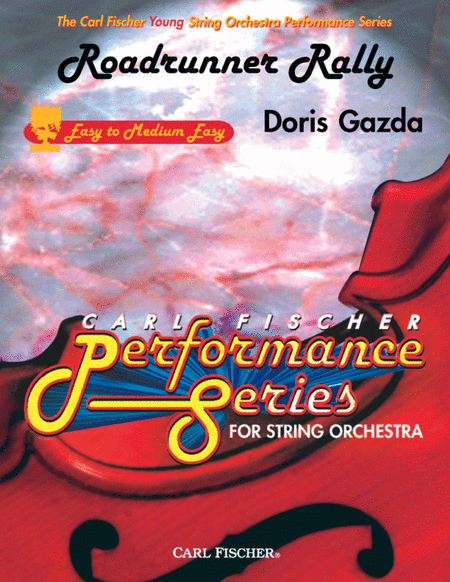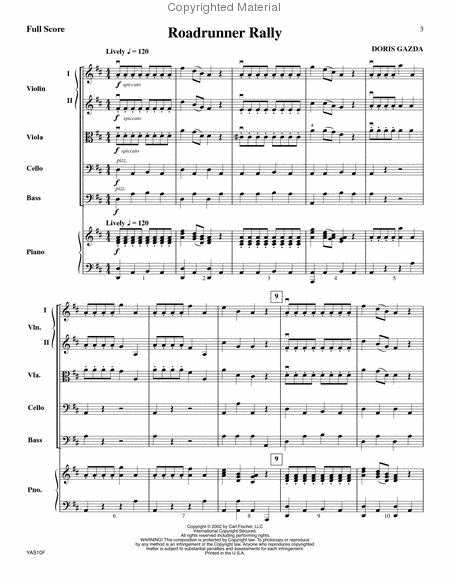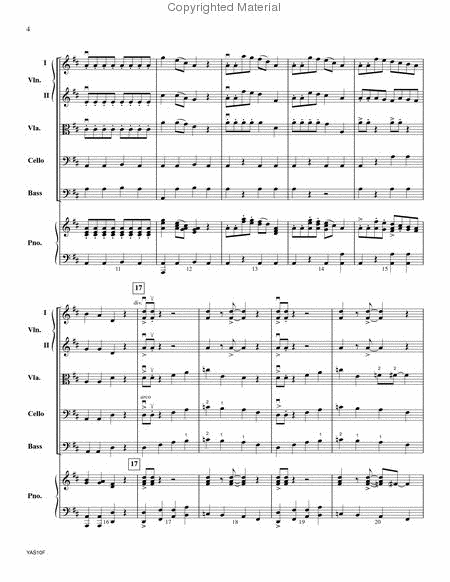Roadrunner Rally
-
Ships in 1 to 2 weeks
Details
Description
SKU: CF.YAS10
Composed by Doris Gazda. Edited by Amy Rosen. Carl Fischer Young String Orchestra Series. Classical. Score and Parts. With Standard notation. 16+4+16+10+10+4+10+12 pages. Carl Fischer Music #YAS10. Published by Carl Fischer Music (CF.YAS10).ISBN 9780825848261. UPC: 798408048266. 8.5 X 11 inches. Key: D major.
When traveling through the desert southwest of the United States, you may be fortunate enough to come across a strange looking brown and white streaked bird called the Roadrunner. It has a blue patch of skin circling the eyes, a tiny dot of bright red behind the eyes, a bushy crest on the top of its head and a long tail that bobs up and down. A member of the cuckoo family, it is New Mexico's state bird, and can run in bursts of speed from between ten to twenty miles per hour. Because it is equipped to run rather than fly, its feet are different from other bird species, having two toes in front and two toes in the back. Its tracks looks like the letter X. Although roadrunners can become airborne, they are basically ground birds and do not fly. They eat insects, scorpions, small rodents, birds, lizards and snakes. They do make noise when in danger; however, the clicks and clatters do not resemble the sound of a honking horn that we think of from the Hollywood cartoon version of roadrunners. The repeated notes in the opening melody of Roadrunner Rally will remind you of the sight of a roadrunner traveling along at breakneck speed. A crisp spiccato accompanied by pizzicato in the cello and bass paints the picture of the bird running through the desert. At m. 17 you will hear that raucous honk, honk that is associated with the roadrunner saying Out of my way! The syncopation can easily be learned by feel as well as by counting carefully. At m. 25 and similar passages, the first violins will have fun learning the jazz licks. The walking bass like at m.69 with the jerky sound of the octaves in the upper strings will remind you of the awkward appearance of this ungainly bird. And of course, Roadrunner Rally ends with a loudly emphasized honking noise, the beep that we associate with the humorous picture of the roadrunner.
When traveling through the desert southwest of the United States, you may be fortunate enough to come across a strange looking brown and white streaked bird called the Roadrunner. It has a blue patch of skin circling the eyes, a tiny dot of bright red behind the eyes, a bushy crest on the top of its head and a long tail that bobs up and down. A member of the cuckoo family, it is New Mexico's state bird, and can run in bursts of speed from between ten to twenty miles per hour. Because it is equipped to run rather than fly, its feet are different from other bird species, having two toes in front and two toes in the back. Its tracks looks like the letter X. Although roadrunners can become airborne, they are basically ground birds and do not fly. They eat insects, scorpions, small rodents, birds, lizards and snakes. They do make noise when in danger; however, the clicks and clatters do not resemble the sound of a honking horn that we think of from the Hollywood cartoon version of roadrunners. The repeated notes in the opening melody ofA Roadrunner Rally will remind you of the sight of a roadrunner traveling along at breakneck speed. A crisp spiccato accompanied by pizzicato in the cello and bass paints the picture of the bird running through the desert. At m. 17 you will hear that raucous honk, honk that is associated with the roadrunner saying Out of my way! The syncopation can easily be learned by feel as well as by counting carefully. At m. 25 and similar passages, the first violins will have fun learning the jazz licks. The walking bass like at m.69 with the jerky sound of the octaves in the upper strings will remind you of the awkward appearance of this ungainly bird. And of course,A Roadrunner Rally ends with a loudly emphasized honking noise, theA beep that we associate with the humorous picture of the roadrunner.
When traveling through the desert southwest of the United States, you may be fortunate enough to come across a strange looking brown and white streaked bird called the Roadrunner. It has a blue patch of skin circling the eyes, a tiny dot of bright red behind the eyes, a bushy crest on the top of its head and a long tail that bobs up and down. A member of the cuckoo family, it is New Mexico's state bird, and can run in bursts of speed from between ten to twenty miles per hour. Because it is equipped to run rather than fly, its feet are different from other bird species, having two toes in front and two toes in the back. Its tracks looks like the letter "X". Although roadrunners can become airborne, they are basically ground birds and do not fly. They eat insects, scorpions, small rodents, birds, lizards and snakes. They do make noise when in danger; however, the clicks and clatters do not resemble the sound of a honking horn that we think of from the Hollywood cartoon version of roadrunners. The repeated notes in the opening melody ofA Roadrunner Rally will remind you of the sight of a roadrunner traveling along at breakneck speed. A crisp spiccato accompanied by pizzicato in the cello and bass paints the picture of the bird running through the desert. At m. 17 you will hear that raucous "honk, honk" that is associated with the roadrunner saying "Out of my way!" The syncopation can easily be learned by feel as well as by counting carefully. At m. 25 and similar passages, the first violins will have fun learning the jazz licks. The walking bass like at m.69 with the jerky sound of the octaves in the upper strings will remind you of the awkward appearance of this ungainly bird. And of course,A Roadrunner Rally ends with a loudly emphasized honking noise, theA beep that we associate with the humorous picture of the roadrunner.
When traveling through the desert southwest of the United States, you may be fortunate enough to come across a strange looking brown and white streaked bird called the Roadrunner. It has a blue patch of skin circling the eyes, a tiny dot of bright red behind the eyes, a bushy crest on the top of its head and a long tail that bobs up and down. A member of the cuckoo family, it is New Mexico's state bird, and can run in bursts of speed from between ten to twenty miles per hour. Because it is equipped to run rather than fly, its feet are different from other bird species, having two toes in front and two toes in the back. Its tracks looks like the letter "X". Although roadrunners can become airborne, they are basically ground birds and do not fly. They eat insects, scorpions, small rodents, birds, lizards and snakes. They do make noise when in danger; however, the clicks and clatters do not resemble the sound of a honking horn that we think of from the Hollywood cartoon version of roadrunners. The repeated notes in the opening melody of Roadrunner Rally will remind you of the sight of a roadrunner traveling along at breakneck speed. A crisp spiccato accompanied by pizzicato in the cello and bass paints the picture of the bird running through the desert. At m. 17 you will hear that raucous "honk, honk" that is associated with the roadrunner saying "Out of my way!" The syncopation can easily be learned by feel as well as by counting carefully. At m. 25 and similar passages, the first violins will have fun learning the jazz licks. The walking bass like at m.69 with the jerky sound of the octaves in the upper strings will remind you of the awkward appearance of this ungainly bird. And of course, Roadrunner Rally ends with a loudly emphasized honking noise, the beep that we associate with the humorous picture of the roadrunner.
When traveling through the desert southwest of the United States, you may be fortunate enough to come across a strange looking brown and white streaked bird called the Roadrunner. It has a blue patch of skin circling the eyes, a tiny dot of bright red behind the eyes, a bushy crest on the top of its head and a long tail that bobs up and down. A member of the cuckoo family, it is New Mexico's state bird, and can run in bursts of speed from between ten to twenty miles per hour. Because it is equipped to run rather than fly, its feet are different from other bird species, having two toes in front and two toes in the back. Its tracks looks like the letter "X". Although roadrunners can become airborne, they are basically ground birds and do not fly. They eat insects, scorpions, small rodents, birds, lizards and snakes. They do make noise when in danger; however, the clicks and clatters do not resemble the sound of a honking horn that we think of from the Hollywood cartoon version of roadrunners. The repeated notes in the opening melody of Roadrunner Rally will remind you of the sight of a roadrunner traveling along at breakneck speed. A crisp spiccato accompanied by pizzicato in the cello and bass paints the picture of the bird running through the desert. At m. 17 you will hear that raucous "honk, honk" that is associated with the roadrunner saying "Out of my way!" The syncopation can easily be learned by feel as well as by counting carefully. At m. 25 and similar passages, the first violins will have fun learning the jazz licks. The walking bass like at m.69 with the jerky sound of the octaves in the upper strings will remind you of the awkward appearance of this ungainly bird. And of course, Roadrunner Rally ends with a loudly emphasized honking noise, the beep that we associate with the humorous picture of the roadrunner.
When traveling through the desert southwest of the United States, you may be fortunate enough to come across a strange looking brown and white streaked bird called the Roadrunner. It has a blue patch of skin circling the eyes, a tiny dot of bright red behind the eyes, a bushy crest on the top of its head and a long tail that bobs up and down. A member of the cuckoo family, it is New Mexico's state bird, and can run in bursts of speed from between ten to twenty miles per hour. Because it is equipped to run rather than fly, its feet are different from other bird species, having two toes in front and two toes in the back. Its tracks looks like the letter "X". Although roadrunners can become airborne, they are basically ground birds and do not fly. They eat insects, scorpions, small rodents, birds, lizards and snakes. They do make noise when in danger; however, the clicks and clatters do not resemble the sound of a honking horn that we think of from the Hollywood cartoon version of roadrunners.The repeated notes in the opening melody of Roadrunner Rally will remind you of the sight of a roadrunner traveling along at breakneck speed. A crisp spiccato accompanied by pizzicato in the cello and bass paints the picture of the bird running through the desert. At m. 17 you will hear that raucous "honk, honk" that is associated with the roadrunner saying "Out of my way!" The syncopation can easily be learned by feel as well as by counting carefully. At m. 25 and similar passages, the first violins will have fun learning the jazz licks. The walking bass like at m.69 with the jerky sound of the octaves in the upper strings will remind you of the awkward appearance of this ungainly bird. And of course, Roadrunner Rally ends with a loudly emphasized honking noise, the beep that we associate with the humorous picture of the roadrunner.



 Share
Share